Sapa is a favorite tourist destination in the northern mountainous region loved by many domestic and foreign tourists. Mentioning Sapa is mentioning the majestic terraced fields, the towering green mountains. Mentioning Sapa also brings to mind the Love Market and the market areas of the indigenous people, where they display and sell colorful pillows, embroidered clothes, bags… with vivid colors and distinctive patterns of the ethnic minorities living here. Mentioning Sapa is mentioning the cool weather, fog, the ancient stone church that has been there for generations, the small villages nestled in the misty mountains with the friendly and genuine ethnic people. To learn about Sapa, especially about the people here and the cultural heritage, history of the indigenous ethnic groups, there is nothing more complete than visiting the Sapa Museum.
Where is the Sapa Museum located?

The Sapa Museum is located within the premises of the Lao Cai Province Tourism Information and Promotion Center. The museum is situated at 2 Fansipan, in the town of Sapa. The Sapa Museum was established and opened in 2007.
Cuong knows that many young people and tourists from Hanoi travel to Sapa in the early spring or summer to escape the scorching heat in the capital. To imagine the Sapa Museum, you can think of it as the Museum of Ethnology or the Women’s Museum in Hanoi, but on a smaller scale. The similarity between the Sapa Museum and the Museum of Ethnology is that both places exhibit many traditional costumes of ethnic groups, reenact daily life scenes, as well as wedding customs, funerals, famous festivals… of the ethnic minorities.
Cuong is sure that just by visiting the Sapa Museum for a day, you will gain a lot of knowledge about the culture, customs, traditions, and history of the northern mountainous ethnic groups living in Sapa. Therefore, Cuong thinks that when traveling to Sapa, a destination that families should visit is the Sapa Museum, where children have the opportunity to learn and explore the culture of the ethnic groups, similar to a combined sightseeing and learning tour. It’s a perfect combination of tourism and education, killing two birds with one stone!
How to get to the Sapa Museum:
Usually when traveling to Sapa, visitors often stay at hotels in the town center. From there, Cuong will guide you on how to get to the Sapa Museum. You can ride a motorbike or bicycle from the town center to the Sapa Museum.
Cuong knows that many Sapa hotels now offer motorbike rental services, or bicycle rentals. Those who are still hesitant about renting a vehicle but don’t know the way can ask the hotel to arrange a guide to take you there. Cuong knows that many hotel staff in Sapa are ethnic people, known for being friendly and hospitable, so you can feel comfortable asking for help. Alternatively, you can take a motorbike taxi, or if you are on a guided tour to Sapa, the whole group can rent a taxi to the Sapa Museum, which is very convenient.
For Cuong, when traveling, Cuong likes to walk to admire the scenery of the place he visits and understand more about the daily life of the local people, so that day Cuong decided to walk to the Sapa Museum, the distance is not far and the road is quite easy to walk. That day, Cuong also took quite a few selfies and beautiful landscape photos of Sapa town.
Entrance fee, opening hours of the Sapa Museum:
The Sapa Museum is open daily from Monday to Sunday from 7:30 am to 11:30 am, and from 1:30 pm to 5:00 pm. Cuong has visited many museums in Hanoi, but most of them are closed on Saturdays and Sundays, but the Sapa Museum is open even on weekends, so those who want to travel to Sapa on weekends can still confidently visit this very attractive destination. Especially on weekends, Cuong still sees many tourists, both domestic and foreign, coming to explore the Sapa Museum.
To create a friendly atmosphere, the Sapa Museum does not charge an entrance fee, admission is free. Everyone is welcomed here as if visiting a friend’s house. This is what Cuong really likes about the Sapa Museum, you don’t have to worry about paying expensive entrance fees at a famous tourist spot, Cuong thinks the Sapa Museum is an ideal destination for students who want to travel to Sapa independently or for those who want to save costs to a minimum when traveling to Sapa. If Cuong were a local living here, he would probably visit the Sapa Museum every weekend, because there is no entrance fee.
The entrance to the Sapa Museum with two stone columns, a green painted iron gate opens inviting you to step in and explore. Walking on the stone-paved path, looking at the tall green pine trees and the museum building in ancient architecture, Cuong feels like stepping into an ancient mansion.
What does the Sapa Museum offer?
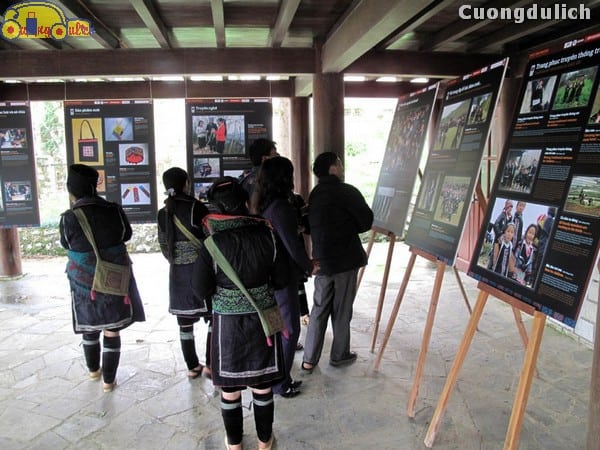
The Sapa Museum was established and operates based on the model of the Arcachon tourist house (Bordeaux – France). The Sapa Museum is a collaboration between Lao Cai province and the Aquitaine region of France.
The Sapa Museum currently preserves about 200 artifacts, models, and many publications, documentaries about the ethnic groups in Sapa such as H’mong, Tay, Giay, Xa Pho, Ha Nhi, and Red Dao. Here, visitors can learn about the history of the formation of Sapa town, as well as explore the production labor, religious activities, culture, and unique costumes of each ethnic group.
When traveling to Sapa, Cuong’s first impression is the very special traditional costumes of the indigenous ethnic groups. Walking on the streets, Cuong sees people in traditional costumes with various colors, patterns, and motifs. This arouses Cuong’s curiosity and desire to learn more about these costumes, as clothing is not just something to wear, it is also a symbol of culture and is closely linked to the history and development of each ethnic group.
Therefore, when visiting the Sapa Museum, Cuong is very pleased because here Cuong can comfortably admire many sets of costumes of the indigenous ethnic groups in Sapa. Cuong can see the loom models of the Thai people to understand how they make those costumes. Cuong learns how the H’mong ethnic group will wear those costumes in daily life, or on special occasions such as festivals, New Year, weddings, funerals, etc.
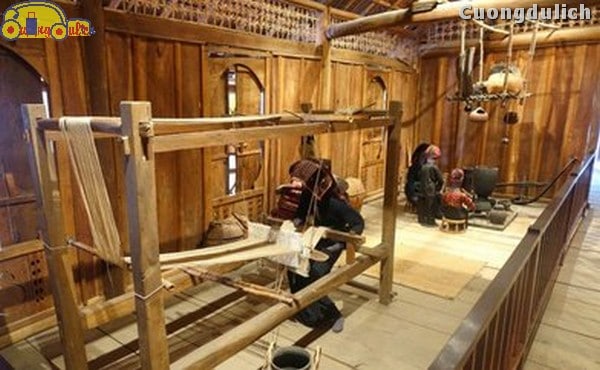
The daily life scene of a Thai family.
At this corner of the Sapa museum, Cuong can admire a corner of a Thai house, with walls and household items mostly made of wood, featuring the distinctive architecture of the ethnic house, completely different from the brick houses of the Kinh people that we are familiar with. Cuong can clearly see where the working area is, such as the area for weaving frames, and where the common living area of the whole family is.
The Sapa museum recreates a model of a Thai family gathering around the fireplace. This is where they gather in the evening to cook, eat, and chat, sharing stories about their day of work. Imagine the scene of an ethnic family sitting around the fireplace, with some food hanging above to be smoked and dried to last longer, you will feel the warm and rich humanity of the Sapa ethnic people just like the fireplace itself.

The model of a Red Dao wedding.
In another corner of the Sapa museum, Cuong can see the scene of a Red Dao wedding. For the majority of us, when we have a wedding ceremony, the groom usually wears a suit, and the bride wears a wedding dress. These are the clothing images that we are familiar with, but only when visiting the Sapa museum, Cuong can see the special traditional costumes of the Red Dao people. Both the bride and groom wear red scarves, and the bride wears a floral shirt. The items we usually see in a wedding ceremony of the majority Kinh people are surely known to all of us, but come to the Sapa museum and observe the scenery, items in their traditional wedding ceremony, to see how different their necessary items are compared to a Kinh wedding, and how simple, modest, and rustic their wedding ceremony looks.
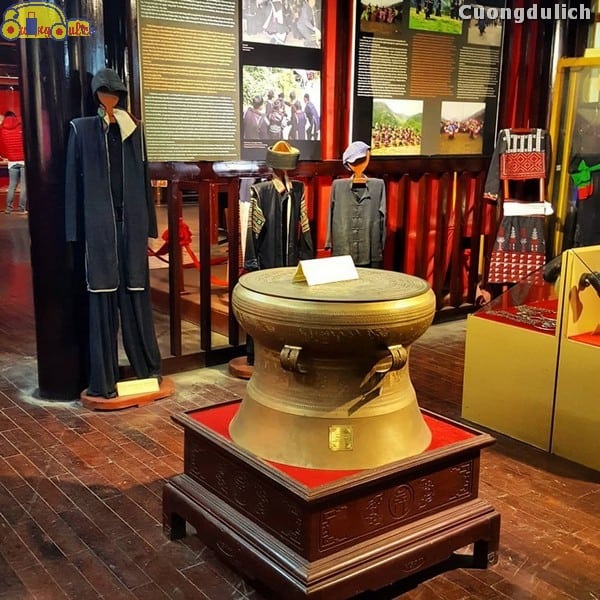
At another corner, you can admire the everyday items used by the indigenous people in Sapa, such as baskets, containers for belongings, and models of stilt houses with walls made of clay and roofs made of straw. In another corner, there is an altar and a storage area of a family from the ethnic minority, with bamboo baskets and gongs hanging in a row on the house’s beam.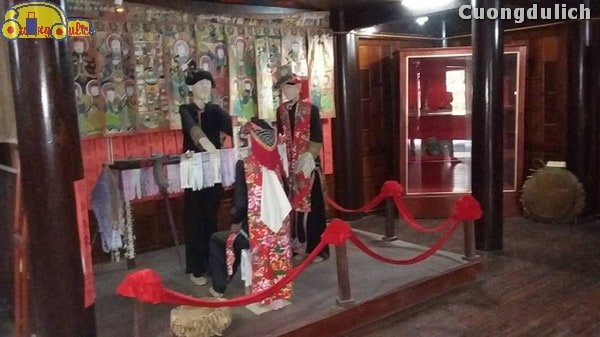
The coming-of-age ceremony of the Red Dao people.
In a certain area, Cuong witnessed the coming-of-age ceremony of the Red Dao people. According to the information Cuong gathered, the coming-of-age ceremony is a traditional ritual of the Red Dao people that has been passed down through generations. A young man of the Red Dao ethnic group, after undergoing the coming-of-age ceremony, is considered a mature man both physically and spiritually. The ceremony usually takes place in the last months of the year. Before the ritual, the person undergoing the ceremony must refrain from using vulgar language, swearing, engaging in marital relations, or paying attention to women. The chosen master of the ceremony must be skillful, the date carefully selected, and the person undergoing the ceremony must be well-versed in the traditional rituals. The coming-of-age ceremony in the family is carried out in order from top to bottom, from father to son, from older brother to younger brother. A ceremony can be performed for several people or just one person, but it must be an odd number. Men with wives are usually chosen to undergo the ceremony first. The most important aspect of the coming-of-age ceremony is the bestowal of a new name to the person undergoing the ritual.
Visit the Sapa Museum to see how the altars are decorated with spiritual paintings and the unique costumes of those participating in the ceremony of the Red Dao people. Cuong guarantees that your Sapa tour will be more meaningful and you will gain a lot of knowledge.
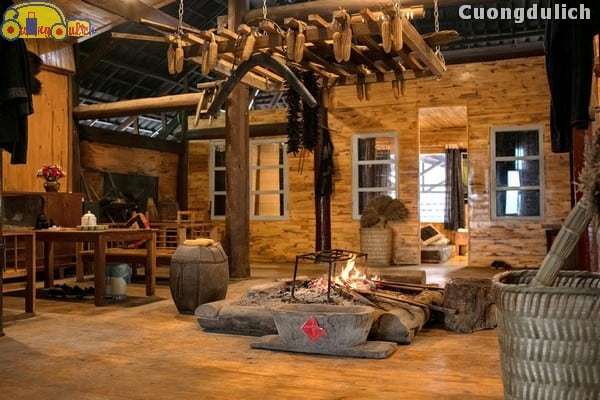
If you are tired of the tall buildings and crowded streets of the city, you will be surprised and fascinated by the stilt houses of the Giay and Tay people, or the earthen wall houses of the H’mong people. They are all very rustic and simple, reflecting the gentle and genuine nature of the indigenous people who have lived in Sapa for generations.
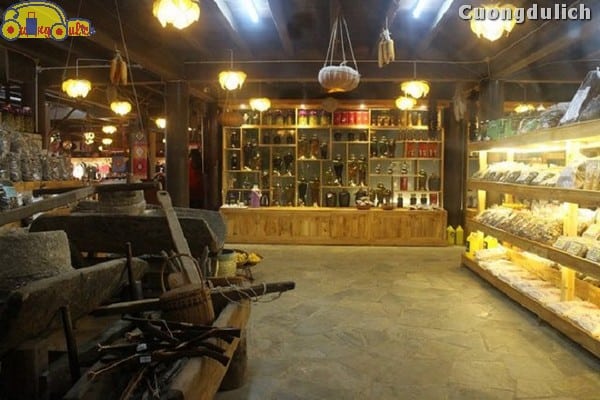
The first floor of the Sapa museum displays many artifacts neatly arranged on wooden shelves, placed under soft yellow lights, all the artifacts seem to reflect the footsteps of time, about the ups and downs in the history of the ethnic communities associated with them.
In addition, the first floor of the Sapa museum also has a display area and sells handicraft products. You can buy small beautiful items or a shirt to commemorate your memorable trip to Sapa. These handicraft items remind Cuong of a glorious era of handicrafts. This is also a new direction for the local people of Sapa, in the context of Sapa tourism flourishing and attracting more and more international tourists.
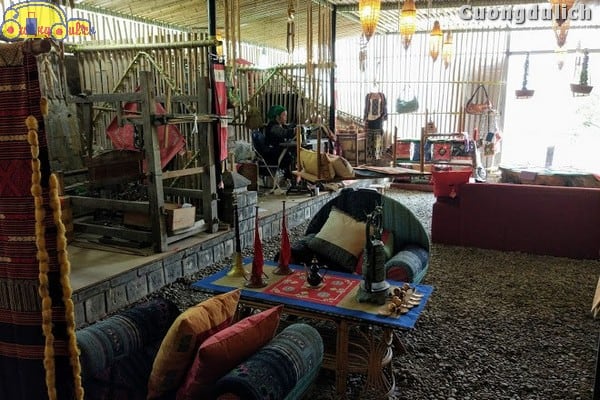
When traveling, we all like to buy local specialties, cute items as souvenirs, and gifts for friends and family, right? Cuong found that on the first floor of the Sapa museum, there are booths displaying local handicrafts, utensils… that you can buy as gifts. Cuong believes that your friends will be very happy to receive unique gifts made by the skilled hands of the ethnic people in Sapa, such as small fragrant brocade bags or a unique patterned scarf. What Cuong greatly admires about the Sapa ethnic women is that with just a simple wooden loom frame, they can skillfully weave intricate patterned scarves and dresses, with various colors intertwined. Perhaps, throughout this country of Vietnam, the hands of these grandmothers, mothers, and sisters are equally diligent, compassionate, hardworking, and meticulous.
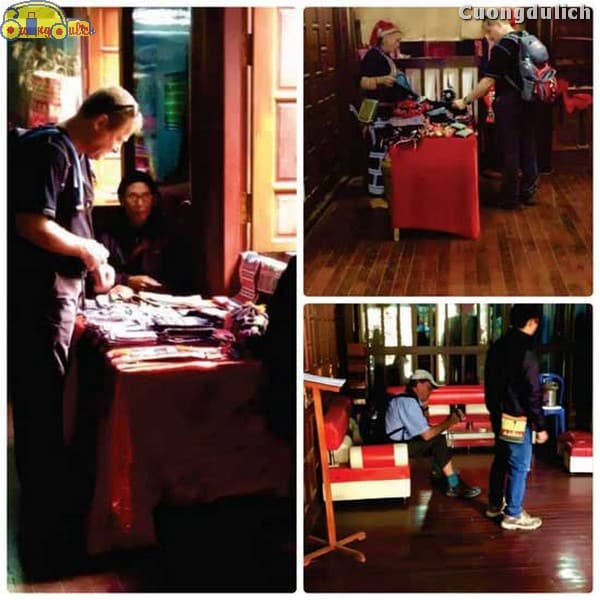
At the souvenir display area, you can witness firsthand how ethnic women weave fabric. If you have some free time, try talking to the elders, Cuong believes you will gain a lot more understanding about the customs and daily life of the people in Sapa. At the end of the visit to the Sapa museum, Cuong bought a beautiful wall hanging cloth as a souvenir, intricately woven and reasonably priced.
Visiting the Sapa museum truly felt like stepping into a market of ethnic people, filled with vibrant colors of carpets and cloths skillfully made by the hands of the Sapa ethnic people displayed and hung on various stalls. It gave Cuong the feeling of a festival, like a Tet market of the Sapa ethnic people with countless bright colors.
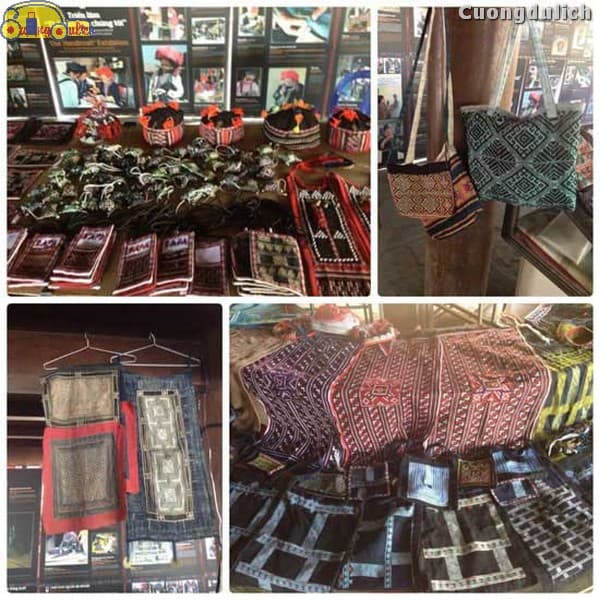
During the tour, Cuong made friends and chatted with Mrs. Sophie White, a tourist from Australia. Mrs. White commented: “We just arrived here, we are excited to see the traditional handicrafts, hand embroidery, it’s wonderful, I have learned a lot even though I just got here.”
Read more:
Extremely Detailed Review of 20 Sapa Travel Destinations for First-Time Visitors to Sapa
10 Hottest Sapa Travel Destinations – Save Now to Avoid Regrets
Top Highlighted Sightseeing Spots in Sapa
Note when visiting and having fun at Sapa Museum:
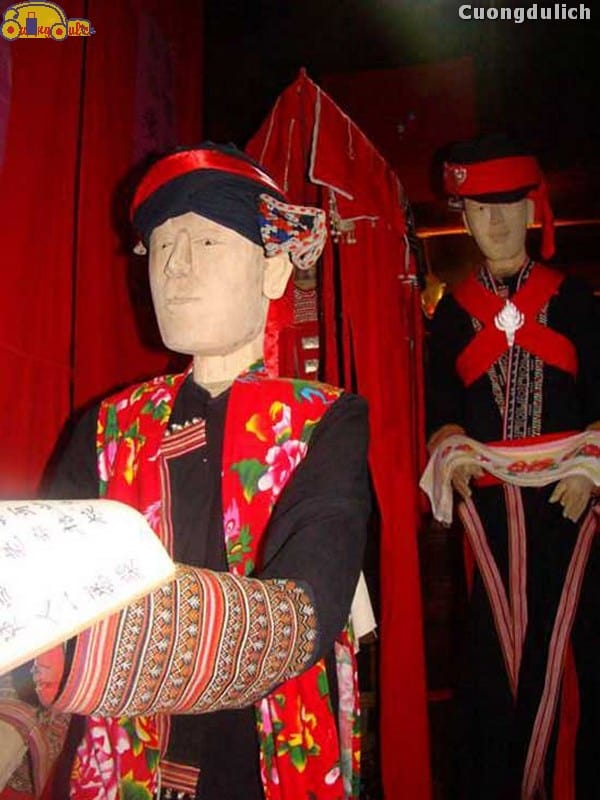
A small note for visitors when visiting the Sapa museum is that, like other museums, tourists are advised not to touch the exhibits to ensure they are not damaged or broken. Cuong knows that nowadays when traveling, many young people have the habit of taking photos with the exhibits to show off to friends on Facebook and keep memories of their visit to such a unique ethnic museum. However, please note to only stand next to the exhibits, or stand outside the area with a barrier, do not touch or move the exhibits. Be polite and conscious tourists to avoid unfortunate incidents.
On weekends, the Sapa museum is quite crowded with visitors, so you may have to wait a bit longer to enter the museum. Or you can choose to go on a Sapa tour on weekdays and visit the Sapa museum on weekdays to avoid the crowds, conveniently look around and read information about the exhibits without worrying about overcrowding.
Attractions near the Sapa museum:
After a day visiting the Sapa museum, if you go on a 2-day 1-night Sapa tour or a 3-day 2-night Sapa tour, on the remaining days, you can spend time visiting many other famous Sapa tourist spots such as ethnic minority villages, Muong Hoa valley, ancient stone church in Sapa, Ham Rong mountain, Cat Cat village…
Muong Hoa Valley
Located in Hau Thao commune, about 12 km southeast of Sapa town center. From Sapa town, crossing a winding mountain pass, tourists will reach Muong Hoa Valley. Visitors here will immerse themselves in the fresh air mixed with beautiful terraced fields, mountains hidden in white mist, glimpses of simple houses, large ancient trees, and beautiful nature.
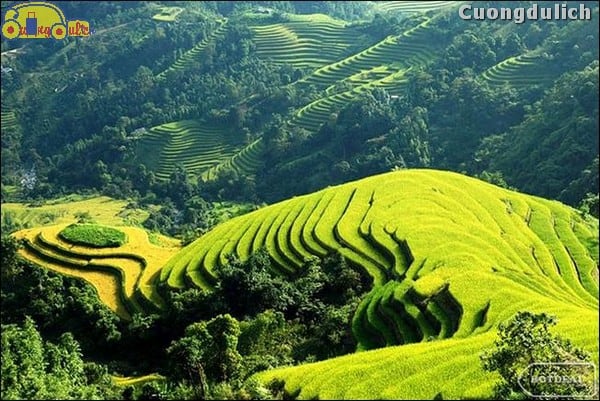
When you come to the Muong Hoa Valley, you will see the cool green terraced fields stretching out as far as the eye can see. I was very impressed by the terraced fields of the Sapa ethnic groups, feeling like a painting and truly admiring how the people of Sapa can create such neatly arranged terraced fields on the hillsides and mountainsides.
The Muong Hoa Valley also has cool, meandering streams running along the terraced fields. During the ripe rice season, the terraced fields turn into golden ripe rice instead of the cool green color before. If you visit the Muong Hoa Valley at the end of late spring, when the ethnic people are watering the terraced fields, these fields look like white silver mirrors, reflecting the sky, and surrounding scenery. In general, I find both the blue sea of rice and the golden rice sea beautiful, capturing extremely beautiful panoramic photos with the winding curves of the terraced fields.
An English tourist I met during my visit to the terraced fields in Muong Hoa had to exclaim, “Now I understand why Telegraph voted Sapa’s terraced fields as one of the most beautiful terraced fields in the world.”
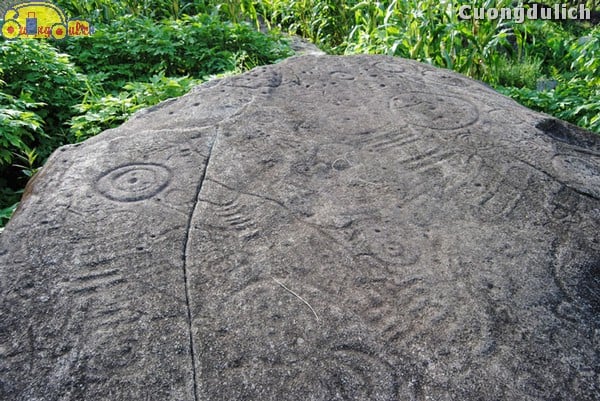
Sapa ancient rock field.
The Muong Hoa valley also has rocky cliffs with attractive rock formations. At the Tả Văn stream, you can relax and bathe in the clear water. Cuong recommends that students, groups of friends should travel to Sapa in the summer to enjoy playing and wading through the cool stream water. Just imagine the feeling of dipping your feet into the stream, and Cuong already feels the coolness all over the body.
The Muong Hoa valley also has the Sapa ancient rock field. This archaeological site covers an area of about 8 square kilometers, discovered in 1925. The Sapa ancient rock field area is vast with nearly 200 rock blocks. But what is special is that these rock blocks have extremely diverse and unique shapes such as stairs, human figures, roads, and writings. Nature is truly miraculous in creating such scenes, isn’t it? Today, this ancient carving area has been classified as a national monument and is a unique heritage of the ancient Vietnamese people. Many scientists both domestic and foreign have come to this ancient rock field area to study the strange writings on the rocks, but have not yet discovered their origins or the process of formation of these rock blocks.
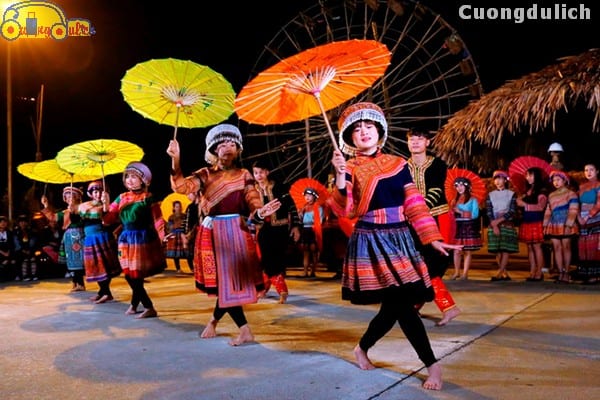
Mường Hoa is the home of many ethnic groups such as H’Mong, Tay, and Tả Van. You can visit the villages of H’Mong, Red Dao, and Giay ethnic groups. Who knows, you might be led by the local people to visit the terraced fields and hear about their farming process, I guarantee there are many differences from the wet rice civilization of the Kinh people.
If you visit the Muong Hoa valley in the early days of the new year, you will have the opportunity to experience the New Year celebration of Tả Van commune. This festival is also known as Pooc Roong. Initially, it was just a traditional festival of the Giay ethnic group, but over the years, it has become a common festival of the entire Muong Hoa valley.
Sapa Stone Church
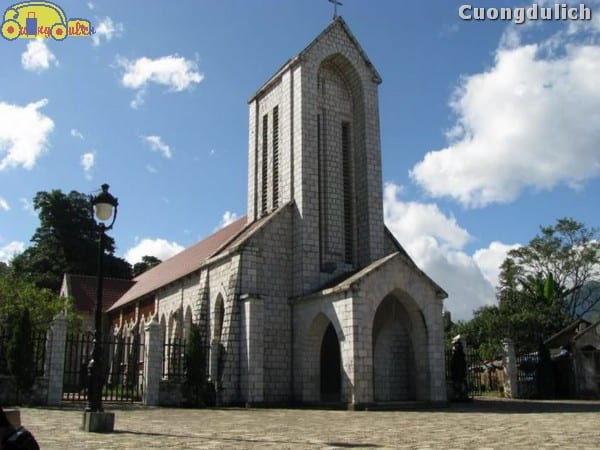
Sapa Church is located in a prime position right in the center of Sapa town, with the Ham Rong Mountain behind it providing shelter, and a wide, flat land in front where colorful festivals of the mountain town take place. Sapa Church was built in 1895 and bears the imprint of French architecture.
The shape and architecture of the church are built in the form of a cross in Romanesque Gothic architecture, reflected in the roofs, bell towers, vaults… all in the form of spires. From the outside, Sapa Stone Church exudes an ancient, misty color, with the outer stone walls tinted with moss. A special feature is the adhesive material binding these stone blocks together, including sand, lime, and molasses.
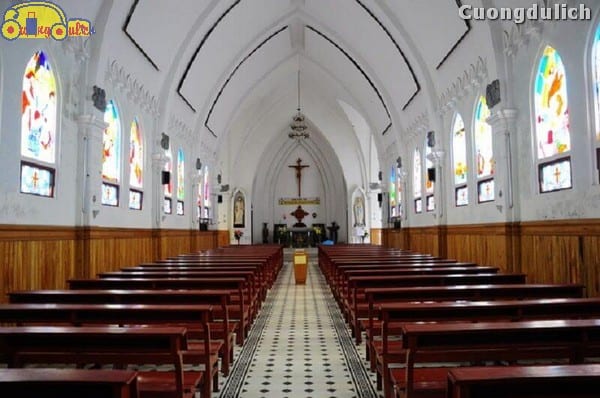
Cuong was particularly impressed with the stained glass windows that depict stories and legends related to the saints in the Catholic faith. On that day at the Sapa church, Cuong went to admire each window to try to understand the stories depicted in the paintings. When traveling to Sapa, remember to visit the stone church, each window will tell you about the life of God.
The Sapa stone church consists of 7 halls covering over 500 square meters, with a bell tower 20 meters high. Inside the tower is a bell weighing 500 kg, when rung, the sound echoes within a mile. With a total area of over 6,000 square meters, the Sapa stone church has enough space to arrange areas including: the church area, the rectory, the priest’s residence, the livestock house, the angel house, the front yard, the fence, the Holy garden area.
The central church is painted white, with a sharp roof structure, rows of neatly arranged benches on both sides of the aisle. When entering the church, Cuong immediately felt a solemn, quiet, and distant space, far from the bustling noises outside.
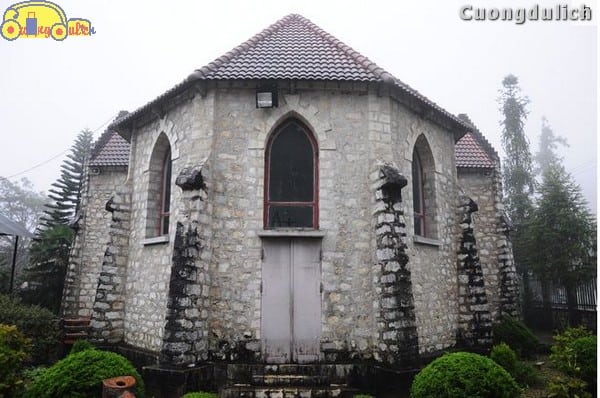
Choosing the orientation of a church is significant for Catholics. The front of the church faces East, welcoming the sunrise, the light of God. At the back of the church, the West direction, is where Christ was born. The prayer activities of the followers of the Catholic faith in the local area take place every weekend. This is also the main gathering place for the churchgoers in Sapa.
The Stone Church of Sapa is a Sapa tourist destination that cannot be missed by those who visit this foggy town. In front of the Stone Church of Sapa is a large square where weekly love markets are held on Saturdays, with the participation of many ethnic boys and girls, with the sound of the flute calling you softly and countless people gathering to exchange goods, creating a bustling scene and the unique character of the highland markets in Northern Vietnam.
Cuong’s first impression of the Stone Church of Sapa was when he took a taxi from a distance towards the center of Sapa town and saw an ancient building with a sharp steeple looming in the mist, standing out against the backdrop of modern restaurants and hotels around. The Stone Church of Sapa truly brings to this bustling tourist town an ancient, solemn, and peaceful atmosphere.
Ham Rong Mountain.
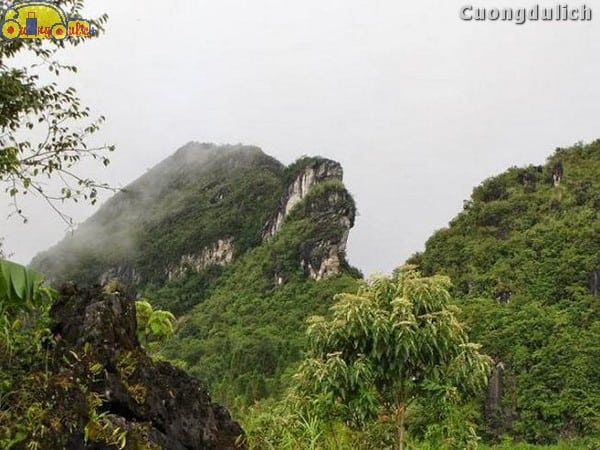
This mountain is located right behind the stone church of Sapa, less than 3 km from the town center, making it quite convenient to travel. This is one of the most famous mountains in Sapa. If you have taken a Sapa tour, very few people skip Ham Rong mountain in their journey. Travel companies often include Ham Rong mountain in their all-inclusive Sapa tour itineraries for tourists.
The reason this mountain is called Ham Rong is because it describes the shape of the mountain as a dragon head reaching up to the blue sky. Along with this mountain is a quite interesting ancient legend. It is said that in this area in the past, there was a pair of dragons in love who were separated by a storm. The strong male dragon luckily escaped, while the female dragon, weaker and exhausted, was submerged in the water, only able to look up at the male dragon flying to the sky. Over time, the female dragon turned into stone, her body becoming the Hoang Lien Son range and her head becoming Ham Rong mountain.
When traveling to Sapa, Cuong stayed at a hotel right next to the stone church of Sapa, so it only takes a short walk from here to Ham Rong mountain. If you want to save energy for climbing the mountain or are afraid of getting lost, afraid of not knowing the way, you can hire a motorbike taxi or some hotels in Sapa currently offer convenient rental services with drivers. One thing Cuong wants to note is that the weather in Sapa is usually cool and cold. Ham Rong mountain is even higher, so remember to wear warm clothes if you go on a Sapa tour in winter or even in summer, you still need warm clothes to avoid getting cold. When Cuong visited Sapa, the entrance fee to Ham Rong mountain was 70,000 VND/ticket. Ticket prices may vary depending on the regulations of the management at different times.

The path up to Ham Rong Mountain is paved with three-level stone steps, making it easy and safe to walk. The higher you climb, the more different beautiful scenes you will encounter. First is the orchid garden with hundreds of rare orchid species showing off their colors. Then there is the ancient peach blossom garden, adorned with the white of pear and plum blossoms. I especially love going on a Sapa tour in spring, and for sure, every time I must go up Ham Rong Mountain to admire the view of the mountain forest immersed in the pink cherry blossom hues.
On Ham Rong Mountain, there is also the Thach Lam Stone Garden, consisting of many giant rock walls, gifted by nature with a unique and majestic landscape. The ancients imagined these rock formations as the scales and hair of a dragon. When visiting the Thach Lam Stone Forest area with hundreds of standing rocks, visitors feel as if they have entered a maze of rocks with no way out.
Cloud Yard.
Many travelers on a Sapa tour want to go to Ham Rong Mountain to hunt for clouds on the mountain peak. Standing in the cloud yard amidst the white of endless vast clouds, I feel like I have entered a fairyland. The incredibly sublime natural scenery has helped me capture many artistic landscape photos.
Heaven’s Gate.
On the way to the Cloud Yard, you will pass through Heaven’s Gate. All these names sound very romantic, don’t they? Heaven’s Gate seems like the path leading you up to the Cloud Yard, to the vast expanse of clouds blending with mysterious white mist as if you are ascending to heaven. The path through Heaven’s Gate is often covered in mystical fog, every step feels like entering a dreamland.

Once you reach the summit of Ham Rong Mountain, you’ll feel like you’re standing on top of the world. Standing at this 2,000m high mountain, you can gaze down at the entire scenery of the town of Sapa below. Go up to the mountain top and look around to see the majestic mountains, the villages blurred in the early morning mist, to see the beauty and grandeur of our Vietnamese nature. Standing before the magnificent nature, we suddenly feel how small we are.
Ham Rong Mountain is known as the “fairy of Sapa tourism”. The wild and fascinating natural scenery, the path up the mountain is not too difficult to walk but still evokes a conquering feeling, very suitable for adventure enthusiasts or those who like adventurous travel, mountain climbing clubs.
In case the Sapa tour groups are crowded, with children or elderly people, you should book a 3-day 2-night Sapa tour or 2-day 1-night Sapa tour at travel companies to have a tour guide describe in detail the interesting things at each stop and ensure safety when climbing the mountain.
Cat Cat Village
When going on a Sapa tour package, you can also visit Cat Cat Village. This is a small village in San Sa Ho commune, Lao Cai. It is a highland village nestled amidst majestic mountains, with many local specialties that make you crave such as corn wine, buffalo meat, and various fruits. Try to get away from the hustle and bustle of urban life and immerse yourself in the peaceful and serene life of the ethnic minority people. That day, Cuong and his group challenged each other not to use their phones but to learn how to live and work like the local people. Cuong thinks this is a great way to learn about the culture and way of life of people in a certain place.
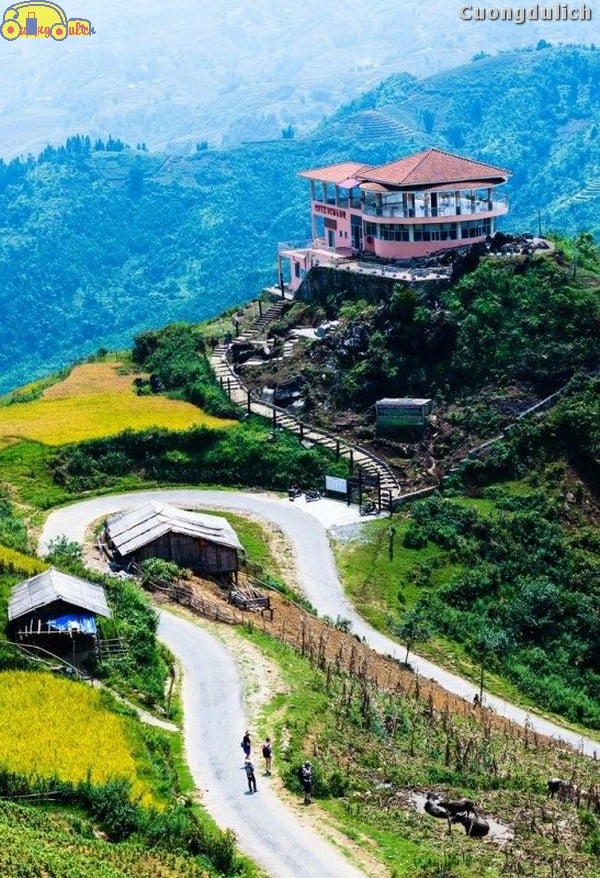
The road from Sapa town to Cat Cat village is about 2 km long. On that road, you will be mesmerized by the vast and majestic landscape, with high mountain ranges on one side and the Sapa valley on the other. This winding road is quite steep and located higher than Cat Cat village, so you will have a panoramic view of the entire village from above, with houses nestled closely together among the cluster of leafy trees.
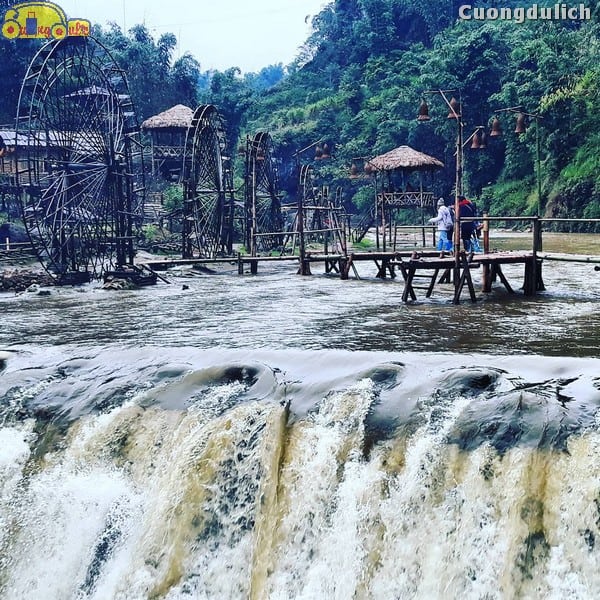
Stepping through the gate leading to the village, you arrive at a narrow stone path between two rows of thatched roof houses displaying various souvenirs made of local clay crafted by the ethnic people themselves. The central area of Cat Cat village is the Hoa stream with its foamy white water, featuring bamboo bridges swaying over the water, giant water mills, and rustic thatched roof houses. Further into the village is the pristine Cat Cat waterfall amidst the rocky mountain landscape, resembling a desert oasis painting.

Cat Cat Village is the home of Hmong families with houses nestled on the hillside. When visiting Cat Cat Village, you will immerse yourself in the gentle dances of Hmong girls, the melodious sounds of the mouth harp, and the lively sapa dances. The Hmong people in Cat Cat also excel in weaving linen fabric, bamboo knitting, silver carving, jewelry making, and blacksmithing. You can even rent traditional costumes to truly feel like a part of the local community.
So Cuong has provided you with a detailed review of the Sapa Museum and nearby Sapa travel destinations. Hopefully, Cuong’s article will help you plan your exploration of the beautiful landscapes and entertainment spots in Sapa and have a memorable Sapa trip. Additionally, you can book all-inclusive Sapa tours for the most specific and detailed itinerary advice!
